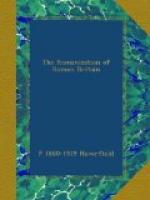[Footnote 1: See Dessau, Hermes, xlvi. 156.]
At this point we might wish to introduce the arguments deducible from philology. We might ask whether the phonetics or the vocabulary of the later Celtic and English languages reveal any traces of the influence of Latin, as a spoken tongue, or give negative testimony to its absence. Unfortunately, the inquiry seems almost hopeless. The facts are obscure and open to dispute, and the conclusions to be drawn from them are quite uncertain. Dogmatic assertions proceeding from this or that philologist are common enough. Trustworthy results are correspondingly scarce. One instance may be cited in illustration. It has been argued that the name ‘Kent’ is derived from the Celtic ‘Cantion’, and not from the Latin ‘Cantium’, because, according to the rules of Vulgar Latin, ‘Cantium’ would have been pronounced ‘Cantsium’ in the fifth century, when the Saxons may be supposed to have learnt the name. That is, Celtic was spoken in Kent about 450. Yet it is doubtful whether Latin ‘ti’ had really come to be pronounced ‘tsi’ in Britain so early as A.D. 450. And it is plainly possible that the Saxons may have learnt the name long years before the reputed date of Hengist and Horsa. The Kentish coast was armed against them and the organization of the ‘Saxon Shore’ established about A.D. 300. Their knowledge of the place-name may be at least as old. No other difficulty seems to hinder the derivation of ‘Kent’ from the form ‘Cantium’, and the whole argument based on the name thus collapses. It is impossible here to go through the whole list of cases which have been supposed to be parallel in their origin to ‘Kent’, nor should I, with a scanty knowledge of the subject, be justified in such an attempt. I have selected this particular example because it has been emphasized by a recent writer.[1]
[Footnote 1: Vinogradoff, Growth of the Manor, p. 102. I am indebted to Mr. W.H. Stevenson for help in relation to these philological points.]
CHAPTER IV
ROMANIZATION IN MATERIAL CIVILIZATION
From language we pass to material civilization. Here is a far wider field of evidence, provided by buildings, private or public, their equipment and furniture, and the arts and small artistic or decorative objects. On the whole this evidence is clear and consistent. The material civilization of the province, the external fabric of its life, was Roman, in Britain as elsewhere in the west. Native elements succumbed almost wholesale to the conquering foreign influence. In regard to public buildings this is natural enough. Before the Claudian conquest the Britons can hardly have possessed large structures in stone, and the provision of them necessarily came in with the Romans. The fora, basilicas, and public baths, such as have been discovered at Silchester, Caerwent and elsewhere, follow Roman models




